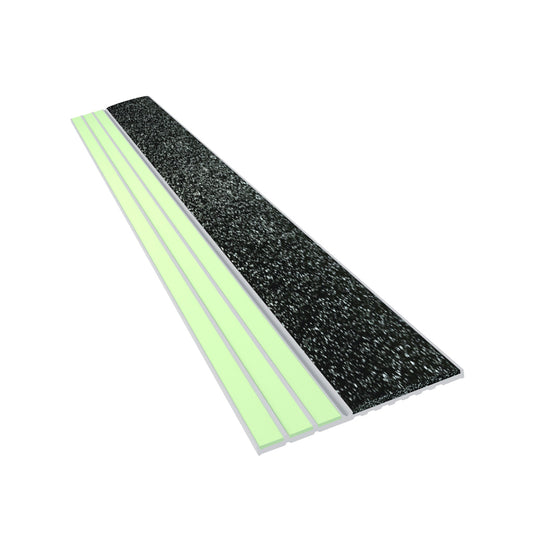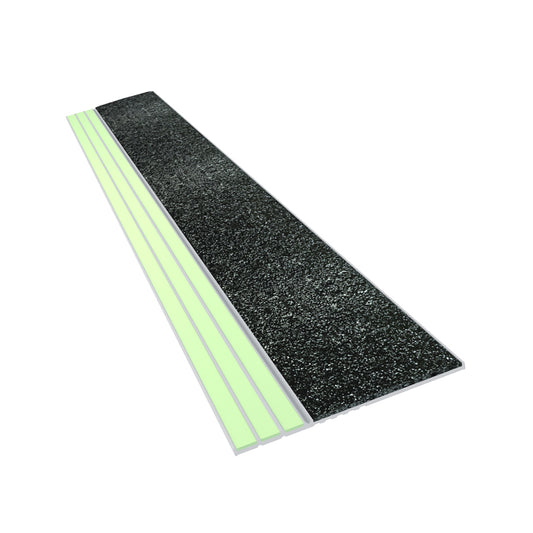
Campus Stair Safety and Emergency Egress: A Guide for Colleges & Universities to Improve Safety of Steps
Share
University Stair Safety & Emergency Egress
Introduction: Where Safety Meets Higher Education
When we think about campus architecture, we often focus on grand lecture halls, green quads, and iconic libraries. But hidden in plain sight, stairwells are quietly critical to campus well-being—serving as daily thoroughfares and emergency lifelines. Whether it's a quick hop between floors for late-night library sessions or a mass evacuation during an alarm, staircase safety is undeniably essential.
In today's higher education landscape—where campuses host thousands of students, faculty, staff, and visitors, many of whom arrive at all hours—recognizing the unique risks of university stairwells is vital. This post digs into why stair safety and emergency egress are particularly critical in colleges and universities, and how institutions can elevate design, compliance, and awareness.
1. Why Stair Safety & Egress Are Non-Negotiable for Universities
1.1 High-Traffic, 24/7 Environments
Colleges and universities bustle from dawn to dusk—and often beyond. Stairwells see constant, sometimes chaotic, foot traffic: crammed hallways during class changes, crowded rushes to evening events, and students zipping down stairs with coffees in hand. These patterns heighten the risk of slips, falls, or more severe injuries.
1.2 Diverse User Base & Varied Behavior
Unlike primary schools, university stairwells are used by a highly diverse demographic: hurried undergraduates lugging heavy backpacks, visiting parents, aging professors, contractors, and maintenance staff. This variety introduces an array of footwear, mobility needs, and hazards—making a one-size-fits-all approach to safety ineffective.
1.3 Aging Infrastructure, Historic Buildings
Universities often juggle preservation and safety. Many campus buildings date back decades (or centuries), with staircases that may lack modern anti-slip surfaces, lighting, or egress features. Retrofitting these legacy structures for safety—without compromising heritage—poses a unique architectural challenge.
1.4 Emergency Complexity on Campus
Emergencies on college campuses can span fires, active code alerts, power outages, or natural disasters. In these situations, stairwells often become the only reliable escape routes—underscoring the need for glare-free illumination, Signage, and unobstructed egress—even in dim or smoky conditions.
2. Regulatory Framework for University Stair Safety
Understanding the rules and codes that apply to stair safety helps inform responsible design and maintenance:
- NFPA & Means-of-Egress Fundamentals: NFPA standards stipulate design priorities like tread depth, riser height, stair width, and landing spacing—values that impact both daily safety and emergency evacuation NFPA.
- University Policies & Obstruction Prevention: Institutions like UNC and Penn State prohibit any obstacles on stairs, landings, or exit paths that may block safety lines. Stairwells must be completely unobstructed, even under stairs—no storage or postings allowed.
- Building Code Minimum Widths: The 2018 International Fire Code calls for a minimum clear width of 48 inches between stair handrails—ensuring sufficient flow during evacuations.
- Egress Layout & Exit Separation: University rooms and corridors must adhere to egress door spacing and exit separation rules—particularly important in large lecture halls or dormitories.
3. Key Considerations for Safe Campus Stairwell Design
3.1 Clear, Uncluttered Pathways
Always maintain stairwells and landings free of obstacles. Furniture, cleaning carts, stored materials—even temporary items—pose tripping hazards and block escape routes.
3.2 Anti-Slip Surface Materials
Install high-traction stair treads—especially on frequently used or outdoor stairs. Options include textured composites, rubber strips, or tread covers designed to prevent slips under wet or worn conditions.
3.3 Lighting & Visibility
Ensure stairs are well-lit at all times with minimum illuminance levels (e.g., 1 foot-candle on walking surfaces). Emergency lighting must engage even during outages. Photoluminescent nosings or strips can guide users in blackout scenarios.
3.4 Emergency Signage & Photoluminescent Pathways
Glow-in-the-dark egress markings (e.g., photoluminescent strips or Signage) are invaluable when power fails or visibility drops. These passive lighting solutions require no power or batteries and remain reliable even in smoky or dark environments.
3.5 Ergonomic Design
Stick with consistent riser heights and tread depths to reduce trip risks. Landings should afford ample space for rest and passing. Handrails must be continuous and at accessible heights, meeting both daily comfort and emergency use.
3.6 Code Compliance Audits
Regularly evaluate stairwells against NFPA, IBC, local fire codes, and campus policy. Audit for obstructions, lighting levels, tread wear, signage clarity, and egress signage visibility—prioritizing areas with high student traffic or known defects.
4. Recommended Safety Technologies & Best Practices
Here are some concrete solutions that campuses are implementing to elevate stair safety:
Photoluminescent Markings & Exit Guidance
- Glow-in-the-Dark Nosings & Path Strips: Apply high-contrast, light-absorbing strips to stair edges so they remain visible during darkness or power loss.
- Directional Egress Signage: Place photoluminescent arrow signs at eye and knee levels to guide evacuees quickly, even in smoke-prone corridors.
Composite or Anti-Slip Covers
- Use composite FRP (fiberglass) tread covers for long-lasting, weather-resistant traction—especially for outdoor or high-use stairways.
- Choose contrasting color nosings (e.g., yellow or bright shades) to highlight each step and assist people with low vision.
Routine Safety Audits & Maintenance
- Schedule frequent inspections—especially before periods of high usage (e.g., semester starts, events).
- Proactively replace worn treads, tighten loose nosings, re-light burned-out fixtures, and refresh Signage before emergencies occur.
Community Education & Signage
- Display signage to remind users about stair safety: "Hold the handrail," "One person per step," or "Keep stairwells clear."
- Educate student groups, event staff, and facility teams on evacuation protocol and safe stair use during drills.
Smart Surveillance & Monitoring
- Use security cameras or sensors to detect stairwell crowding or blockages—particularly during dorm move-ins or large receptions.
- Integrate with campus alert systems for early warnings during over-crowding or smoke detection—prompting action before conditions worsen.
An Example Stair Safety Initiative at a University
Note: University X is a hypothetical example for illustration.
Background
University X—an institution with over 20,000 students and a mix of historic and modern buildings—with stair accidents: minor falls, lighting failures, and blocked egress routes in older residence halls.
Recommended Actions:
1. Comprehensive Audit: Conduct a campus-wide audit of all staircases by the safety and facilities staff.
2. Implementation suggestions:
- Install photoluminescent nosings and exit signage in priority stairwells.
- Retrofit high-traffic stairs with composite anti-slip tread strips.
- Upgrade lighting to LED fixtures with battery backup in all stairwells.
- Remove all storage from stair landings and corridors.
3. Training:
- Conduct awareness campaigns with volunteers demonstrating safe stair use.
- Share evacuation guides via posters and campus websites.
4. Monitoring:
- Install simple motion-triggered cameras in key stairwells (monitored by campus security).
- Incorporate stair checks into regular facility maintenance.
6. Key Takeaways for University Safety Officers
Clear Pathways: No obstructions on stairs, landings, or egress routes at any time. Regularly enforce policy.
Surface Safety: Install anti-slip materials fitted for high traffic and aging infrastructure; contrast edges for visibility.
Lighting & Signage: Ensure adequate day/night lighting. Use photoluminescent nosings and signage to support visibility under power failure.
Design Consistency: Maintain uniform riser/tread dimensions, handrail continuity, and safe landing dimensions.
Code Compliance: Keep staircases compliant with NFPA, IBC, and local code requirements for width, exit separation, and signage.
Audits & Maintenance: Perform routine inspections, repair worn surfaces, replace outdated lighting, and reapply visibility features as needed.
Awareness & Training: Educate building users—students, staff, visitors—on safe stair behavior and evacuation protocols, especially during emergency drills.

Frequently Asked Questions on Stair Safety at Universities & Colleges (FAQ)
1. Why is stair safety so crucial on college and university campuses?
Stair safety is essential because campus stairwells handle heavy foot traffic daily and serve as primary evacuation routes during emergencies. Preventing slips, trips, and falls protects students, faculty, and visitors while ensuring compliance with safety codes.
2. What does “emergency egress” mean in a university setting?
Emergency egress refers to the safe and unobstructed exit routes from a building during emergencies. In universities, this includes stairwells, corridors, and exits that must remain clear, well-lit, and code-compliant to allow quick evacuations.
3. What are the most common stair safety hazards in higher education?
Common hazards include poor lighting, slippery or worn treads, blocked landings, inconsistent riser heights, and inadequate signage. In older buildings, outdated stair designs can also contribute to accidents.
4. How can universities improve stair safety in older or historic buildings?
Universities can retrofit older stairs with anti-slip treads, install photoluminescent nosings for visibility, upgrade lighting, ensure consistent dimensions, and maintain clear egress routes—all while preserving architectural integrity.
5. Are there specific building codes universities must follow for stair safety?
Yes. Institutions must comply with standards from the International Building Code (IBC), NFPA Life Safety Code, and local fire and safety regulations. These codes cover stair width, riser height, tread depth, handrails, lighting, and signage requirements.
6. What role do photoluminescent markings play in stair safety?
Photoluminescent markings glow in the dark, guiding people safely down stairwells during power outages, fires, or low-visibility conditions. They’re an affordable, maintenance-free safety enhancement.
7. How often should stairwells be inspected on campus?
Best practice is to conduct monthly visual inspections, with more thorough safety audits at least twice a year. High-traffic buildings may require weekly checks, especially before major campus events.
8. How can universities educate students and staff about stair safety?
Institutions can promote awareness through safety signage, digital campaigns, emergency drills, and orientation sessions. Simple reminders like “Hold the Handrail” can help reduce accidents.
9. What’s the difference between daily stair safety and emergency egress safety?
Daily stair safety focuses on preventing slips, trips, and falls during normal use. Emergency egress safety ensures stairwells function as fast, unobstructed, and visible evacuation routes during emergencies.
10. Who is responsible for stair safety on campus?
Responsibility often falls to campus facilities management, environmental health and safety departments, and building managers. However, everyone—from staff to students—shares a role in keeping stairs clear and reporting hazards.
Stair Safety on Every Campus
In the dynamic and high-density environment of colleges and universities, stair safety and emergency egress design are mission-critical. These seemingly utilitarian spaces play outsized roles in everyday movement and emergency escapes alike.
By combining strategic design improvements—like anti-slip materials, photoluminescent visibility, lighting upgrades, and strict obstruction-free policies—with community awareness and routine audits, campuses can significantly improve safety and compliance.
Every step taken toward safer stairwells protects lives, reduces liability, and supports the educational mission at its core. Whether you're overseeing safety at an ivy-tower dorm, a modern classroom block, or a historic academic hall, stair safety deserves your fullest attention.










